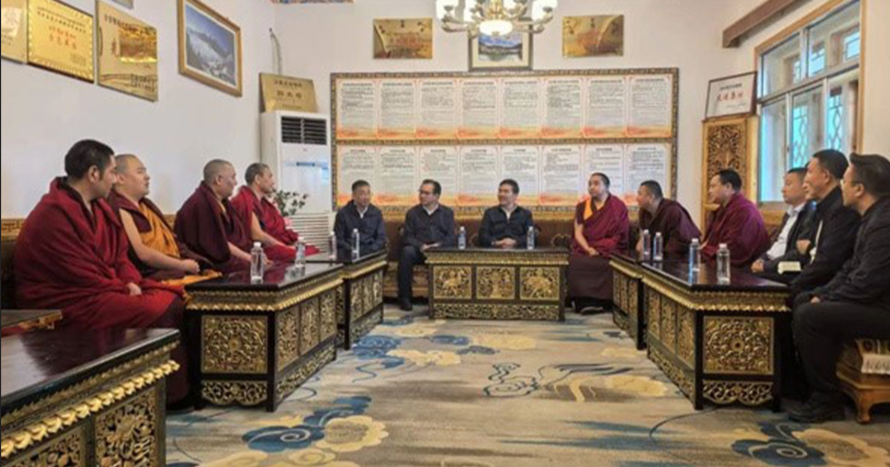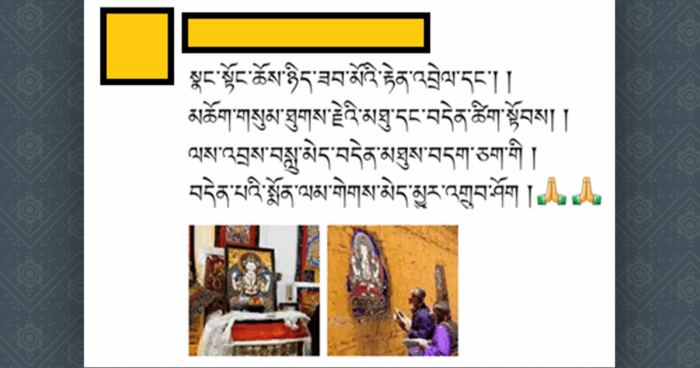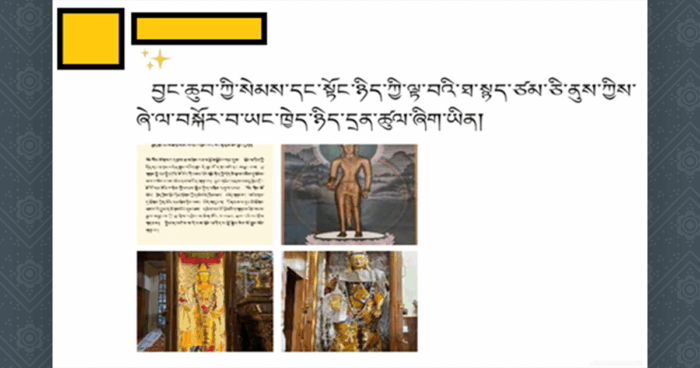As thousands of Tibetans and supporters around the world gathered to celebrate the 90th birthday of His Holiness the Dalai Lama on 6 July , major commemorations took place in Dharamsala, India — the seat of the Tibetan exile community. These included an official function organized by the Central Tibetan Administration, attended by foreign dignitaries and representatives, as well as a high-level meeting of the head lamas of Tibetan Buddhism, reaffirming support for the continuation of the Dalai Lama institution. The events drew considerable attention from international media.
In stark contrast, inside Tibet, the atmosphere remained tense and subdued. Heightened police and military presence has been reported in, but not limited to, the following Tibetan areas, cities and towns[1]:
- Lhasa city, Tibet Autonomous Region (TAR);
- Ngaba County (རྔ་བ་རྫོང་) (阿坝县), Ngaba (Aba) Tibetan and Qiang Autonomous Prefecture (TQAP), Sichuan province;
- Dzoge county (མཛོད་དགེ་རྫོང་།) (若尔盖县), Ngaba prefecture;
- Nyakchu County (ཉག་ཆུ་རྫོང་།) (雅江县) (Yajiang County), Kardze (Ganzi) Tibetan Autonomous Prefecture (TAP), Sichuan province;
- Lithang County (ལི་ཐང་རྫོང་།) (理塘县) in Kardze prefecture;
- Kumbum Monastery (སྐུ་འབུམ་བྱམས་པ་གླིང་) (塔尔寺), Xining, Qinghai province;
- Labrang Monastery (བླ་བྲང་) (拉卜楞寺), Sangqu (Xiahe) County, Kanlho (Gannan) TAP, Gansu province;
- Ngago (སྔ་སྒོ་ཡུལ་ཚོ།) village, Hezuo (གཙོས་གྲོང་ཁྱེར) city in Kanlho prefecture;
- Luchu County (ཀླུ་ཆུ་རྫོང་།) (碌曲县), Kanlho prefecture;
- Xiahe County 夏河县 བསང་ཆུ་རྫོང་,། Kanlho prefecture;
- Pema County (斑玛) པདྨ་རྫོང་།, Golog (Guluo) TAP, Qinghai province;
- Kangtsa County (刚察县) རྐང་ཚ་རྫོང་།, Tsojang (Haibei) TAP, Qinghai province.
Numerous Chinese government officials have conducted visits to Tibetan areas and monasteries across Tibet in the lead-up to the 6 July birthday of the Dalai Lama, reflecting a broader strategy to enforce ‘stability.’ State media heavily promoted these government activities to ramp up warnings against expressions of support for the Dalai Lama. The areas included cities and towns in the Tibet Autonomous Region, Qinghai Province, and Sichuan Province, while other parts of Tibet may also have been targeted.[2]

Despite this climate, and consistent with the Tibetan spirit, many Tibetans released songs and sent well wishes to the Dalai Lama symbolizing acts of reverence to mark his birthday. Ahead of the birthday, the International Campaign for Tibet (ICT) issued the report “Celebrating in fear – China’s crackdown on Dalai Lama birthday tributes in Tibet”, detailing the persecution of Tibetans who celebrated the Nobel Peace Prize laureate’s birthday in the past.
Tencho Gyatso, president of the International Campaign for Tibet (ICT), said, “The heightened security around the Dalai Lama’s birthday shows that the Chinese government is conscious of the fact that its rule in Tibet does not enjoy support and legitimacy among Tibetans. We acknowledge the courage of many Tibetans in Tibet to express reverence to the Dalai Lama despite the pervasive climate of fear instilled by the authorities.”
Heightened military presence and surveillance
According to International Campaign for Tibet sources inside Tibet, between 1-6 July 2025, government officials held meetings in all monasteries across Lhasa to warn against “anti-separatist” activities, including targeting the major monastic learning centers of Drepung and Ganden. Military personnel also conducted 24-hour patrols in residential areas of Lhasa with significant Tibetan populations. Even food delivery drivers were allegedly forced to act as informants, monitoring people’s movements and activities.
In the lead up to the birthday, the Chinese government also carried out various propaganda activities in the Lhasa area. On 30 June, Wang Junzheng, the Party Secretary of the Tibet Autonomous Region, met with the Chinese-selected Panchen Lama Gyaltsen Norbu.[4] During their meeting, Wang emphasized the importance of upholding the banner of “patriotism and love for party, ’unequivocally’ safeguarding national unity and ethnic solidarity, and opposing separatism”.
For a few days in July, the Chinese government specifically arranged for the Norbu to carry out “religious activities” in the Lhasa area. This aligns with the Chinese government’s usual practice of utilizing him during important dates in Tibet to obscure information about the Dalai Lama and external news from the devout public.[5] The official Chinese Tibet Daily newspaper reported that during his activities in Lhasa, Norbu emphasized the need to “deeply study and implement the Party’s Tibet governance policies to promote ethnic unity, religious harmony, and stability, development, and progress in Tibet.” He also stressed ensuring “harmony and stability in the religious sphere” was a crucial political task, which involves “providing education and guidance to monks and nuns on managing religious affairs in accordance with the law”.
Strict social media and public gathering bans
Sources inside Tibet have also reported that previously active and politically engaged areas of Ngaba and Dzoge are under intense “stability maintenance” measures. These measures include prohibiting the sharing of images of the Dalai Lama or other religious symbols on social media and bans on public gatherings for religious rituals or celebrations.
Officials across Kanlho also heightened restrictions. The official Kanlho Prefecture News Agency reported that since 5 July, He Maobao, the Prefecture Party Secretary, has been conducting inspections at Labrang Monastery (བླ་བྲང་དགོན།), Terlung Monastery (གཏེར་ལུང་དགོན།), and Kirti Monastery (ཀིརྟི་དགོན) (Sangchu county branch).
Later, on 8 July, Yang Wu, the Deputy Party Secretary of Kanlho Prefecture, reportedly conducted a follow-up inspection tour of Labrang Monastery and Amchok Monastery.[6]
The top-down controls were also felt in Ngago (སྔ་སྒོ་ཡུལ་ཚོ།) village, Tsoe (གཙོས་གྲོང་ཁྱེར) city in Kanlho. According to a source, around the time of the Dalai Lama’s birthday, Chinese authorities searched more than 40 households and confiscated his photographs as well as those of high lamas living abroad. There are also reports that Tibetans were subjected to beatings and other forms of harassment.
Officials across Kardze TAP in Sichuan were also on alert. According to sources, in Lithang and Nyakchu counties, the Chinese government reportedly gathered all local leaders and issued directives to prevent any political issues around 6July.
Propaganda campaigns in monasteries
During the inspections at Labrang Monastery, police and relevant officials scrutinized monastery affairs.[7] It was also stated that monks must obtain permission to leave the monastery and that religious activities must be strictly managed.
In both Labrang Monastery and across Luchu County, local officials held propaganda campaigns that promoted the “sinicization of Tibetan Buddhism,” banned “anti-separatism,” and demanded acceptance of China’s stance on the Dalai Lama’s reincarnation.
At Kumbum Monastery, in Amdo, Xining, first expanded by the third Dalai Lama and closely linked to the 14th Dalai Lama’s search and early life, sources in the region reported armed police conducted patrols and searched pilgrims and visitors on the Dalai Lama’s birthday.
These measures are consistent with the Chinese government’s long-standing policy of suppressing any expression of reverence for the Dalai Lama and asserting control over Tibetan religious practices, especially during significant dates like the Dalai Lama’s birthday.
Acts of Reverence
Despite the strict measures, some Tibetans inside Tibet marked the Dalai Lama’s birthday on social media platforms. Among them, a young Tibetan singer released a cover of an old song revering the Dalai Lama, which was widely shared on social media both inside and outside Tibet.
Translated extract of song lyrics:
“Born in Amdo (Eastern Tibet)
Having set foot in U-Tsang,
Whose activities are sustained from India,
Missing you, the Prince of Peace.”
Many Tibetans also shared symbolic images online with prayers for the Dalai Lama’s long life and good health. Some were more careful and creative when expressing their support. One message featured images of Chenrezig, the Buddha of Compassion (the Dalai Lamas are believed to be his manifestation) accompanied by the last stanza of a prayer ‘Words of Truth,’ composed by the Dalai Lama in 1960.[8]
Image 1: Social media post of support for the 14th Dalai Lama on 6 July 2025.

Translation of post: By the profound interdependence of emptiness and relative forms,
Together with the force of great compassion in the Three Jewels and their Words of Truth,
And through the power of the infallible law of actions and their fruits,
May this truthful prayer be unhindered and quickly fulfilled.
Another post focusing on remembering the Dalai Lama by practicing the core tenets of Buddhism (see image 2), stating,
“Focusing on achieving Bodhicitta and understanding emptiness as much as possible in itself is a form of remembrance of you.”
Image 2: Social media post expressing reverence to the 14th Dalai Lama on 6 July 2025.

Footnotes:
[1]Note on geographical terminology: Tibet is comprised of three main areas: Amdo (north-eastern Tibet), Kham (eastern Tibet) and U-Tsang (central and western Tibet). The so called Tibet Autonomous Region was set up by the Chinese government in 1965 and covers the area of Tibet west of the Dri-chu (Yangtse river), including part of Kham. The rest of Amdo and Kham have been incorporated into Chinese provinces, and where Tibetan communities were said to have ‘compact inhabitancy’ in these provinces they were designated Tibetan autonomous prefectures and counties. As a result most of Qinghai and parts of Gansu, Sichuan and Yunnan provinces are acknowledged by the Chinese government to be ‘Tibetan.’ ICT uses the term ‘Tibet’ to refer to all Tibetan areas currently under the jurisdiction of the People’s Republic of China.
[2]Luqu County Media Center, 8 July 2025, ཀན་ལྷོ་ཁུལ་གྱི་དམར་ཤོག་དྲུང་ཆེ་ཧོའོ་མའུ་བྷོ་ཡིས་ཀླུ་ཆུ་རྫོང་དང་དགོན་པ་ཁག་ཏུ་རྟོག་ཞིབ་བྱས། (“Gannan Prefecture Party Secretary Hao Maobo Inspects Luqu County and Monasteries’), https://mp.weixin.qq.com/s/XoyYrxHw40o_jEZg3uG5Rw; Tibet United Front Platform, 7 July 2025, ‘斯朗尼玛:坚持 “四条标准” 大力培养爱国爱教的宗教界代表人士’ (‘Sonam Nima: Adhere to the “Four Standards” and vigorously cultivate religious representatives who love the country and the religion’), https://mp.weixin.qq.com/s/iv2P5zyEgBqd-_yzGHyl0g; Luqu County Media Center. 9 July 2025, ‘孙雪涛在甘南调研时强调 依法加强宗教事务管理 深入推进新时代党的治藏方略走深走实’ (‘During his research in Gannan, Sun Xuetao stressed the need to strengthen the management of religious affairs in accordance with the law and to further promote the Party’s Tibet governance strategy in the new era’), https://mp.weixin.qq.com/s/z9-psuTmkHzO3HkAcQAsNQ; Dege County Media Center, 9 July 2025, 县级联系领导到卡松渡乡督导宣传工作 (‘County-level leaders went to Kasongdu Township to supervise the publicity work’), https://mp.weixin.qq.com/s/QYbNKieZ1QpZS7kJpaDxvQ; Party building at Mount Everest in Shigatse Platform, 8 July 2025, ‘达娃次仁在市信访局接达娃次仁在市信访局接待来访群众’ (‘Dawa Tsering emphasized when receiving visitors at the Municipal Petition Bureau’), https://mp.weixin.qq.com/s/blxFsaiYNaEsuKVK3c6PTQ; Aba bodhi Temple. 7 July 2025, ‘系牢同心结 共创好生活——2025年 “觉姆美好生活行动计划” 培训班顺利结业’ (‘‘Tie the knot of unity and create a better life together’), https://mp.weixin.qq.com/s/ufKDKEIqcKI153x3jhngrQ; Qinghai Tibetan Broadcasting, 9 July 2025, ‘ཀྲུང་གུང་ཀྲུང་དབྱང་ཆབ་སྲིད་ཅུའུ་ཡི་རྒྱུན་ལས་ཨུ་ཡོན། རྒྱལ་ཡོངས་དམངས་ཆེན་རྒྱུན་ལས་ཨུ་ཡོན་ལྷན་ཁང་གི་ཨུ་ཡོན་ཀྲང་ཀྲའོ་ལི་ཅི་ཡིས་ཟླ7པའི་ཚེས6ཉིན་ནས་ཚེས8ཉིན་བར་མཚོ་སྔོན་དུ་རྟོག་ཞིབ་བྱས།’ (‘Zhao Leji, a Member of the Standing Committee of the Political Bureau of the Central Committee of the Communist Party of China and Chairman of the Standing Committee of the National People’s Congress, conducted an inspection tour in Qinghai from July 6th to July 8th’), https://mp.weixin.qq.com/s/nP742EMyXkbhjAQZWbOEQA;
Tibet United Front Platform, 7 July 2025, ‘王君正在自治区党委组织部调研’ (‘‘Wang Jun is conducting research at the Organization Department of the Autonomous Region Party Committee’’), https://mp.weixin.qq.com/s/BX6rkl0xN7MrbSUHt8eQ_Q; Jilong Release, 9 July 2025. ‘党的创新理论大众化, སེ་འབྲུའི་རྡོག་ལྟར་གོང་བུ་གཅིག་ཏུ་སྒྲིལ།’ (‘Unite like pomegranate seeds’’), https://mp.weixin.qq.com/s/ga1ACrV-M_cbUaC1mRQkcw; Three-color Banma Tibetan Edition, 1=7 July 2025, ‘བཀྲ་ཤིས་དོན་གྲུབ་ཡུལ་ཚོ་སོཊ་སུ་སོང་ནས་གཙོ་གནད་བྱ་བར་རྟོག་ཞིབ་གནང་།’ (‘The deputy secretary of the county party committee and the county head Tashi Dondup investigates and supervises Villages’’), https://mp.weixin.qq.com/s/eUu-rWpPX8_1ZJHiWeyQXw.
[3]Gansu United Work Front, 9 July 2025, ‘孙雪涛在甘南调研时强调
依法加强宗教事务管理 深入推进新时代党的治藏方略走深走实’ (‘Sun Xuetao stressed during his research in Gannan: Strengthen the management of religious affairs in accordance with the law and deepen the Party’s Tibet governance strategy in the new era’), https://www.gsswtzb.gov.cn/news/show-50680.html.
[4]Tibet Daily, 3 July 2025, ‘རང་སྐྱོང་ལྗོངས་ཏང་ཨུད་ཀྱི་ཧྲུའུ་ཅི་ཝང་ཅུན་ཀྲེང་གིས་ལྷ་སར་པཎ་ཆེན་ཨེར་ཏེ་ནི་ཆོས་ཀྱི་རྒྱལ་པོར་མཇལ་འཕྲད་གནང་བ་རེད།འཕྲད་གནང་བ་རེད།’ (‘ Wang Junzheng, Chairman of the Tibet Autonomous Region, meets with the 11th Panchen Lama in Lhasa’ ), https://mp.weixin.qq.com/s/WBB4H-dIPeIcjyRaFv9TTg.
[5]China Tibetan Network, 9 July, ‘པཎ་ཆེན་ཨེར་ཏེ་ནིས་ལྷ་སར་ཆོས་ཕྱོགས་ཀྱི་མཛད་སྒོ་སྤེལ་བ།’ (‘The Panchen Lama holds religious ceremony in Lhasa’’), https://mp.weixin.qq.com/s/fPYX-pCKNuhdtkSfSd9qxw.
[6]Gannan Media Tibetan Platform, 8 July 2025 , དབྱང་ཝུའུ་ཡིས་བསང་ཆུ་རུ་བྱ་བར་བརྟག་ཞིབ་དང་མཛུབ་སྟོན་བྱས། (‘Yang Wu inspected and guided the work in Bsangchu’), https://mp.weixin.qq.com/s/kWldxvS8b6b4tZonSuz2LQ.
[7]Gannan Media Tibet Platform, 5 July 2025, ‘ཧོ་མོའུ་པའོ་ཡིས་བསང་ཆུ་དང་གཙོས་སུ་བྱ་བར་རྟོག་ཞིབ་བྱས།’ (‘Ho Mou Bao inspects the work of Hezuo city in the Kanlho’’), https://mp.weixin.qq.com/s/dfS2pjDEprSWh80VXurQPQ.
[8]His Holiness the 14th Dalai Lama of Tibet, ‘Teachings: Words of Truth’’, https://www.dalailama.com/teachings/words-of-truth.